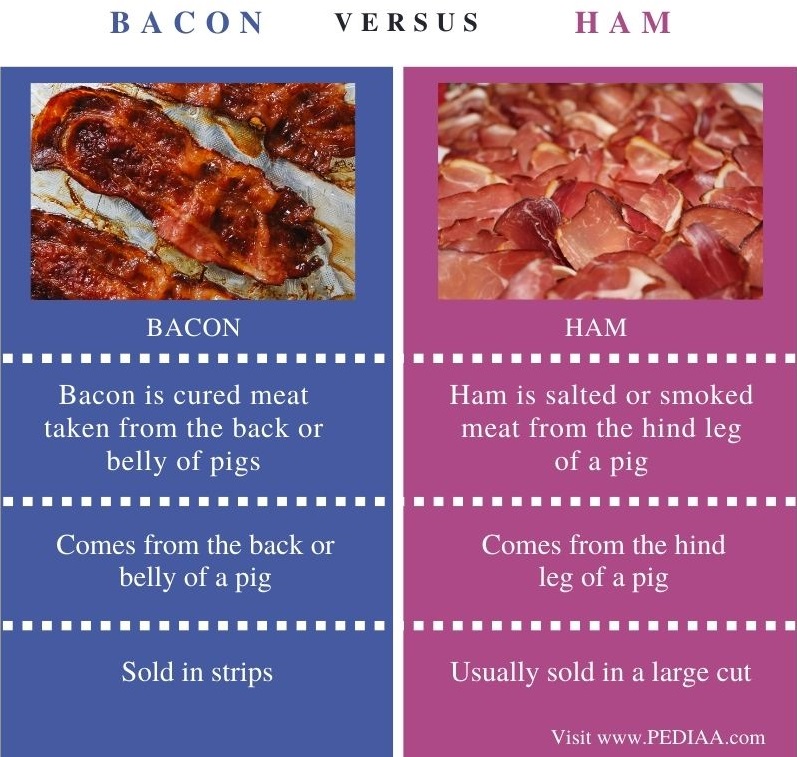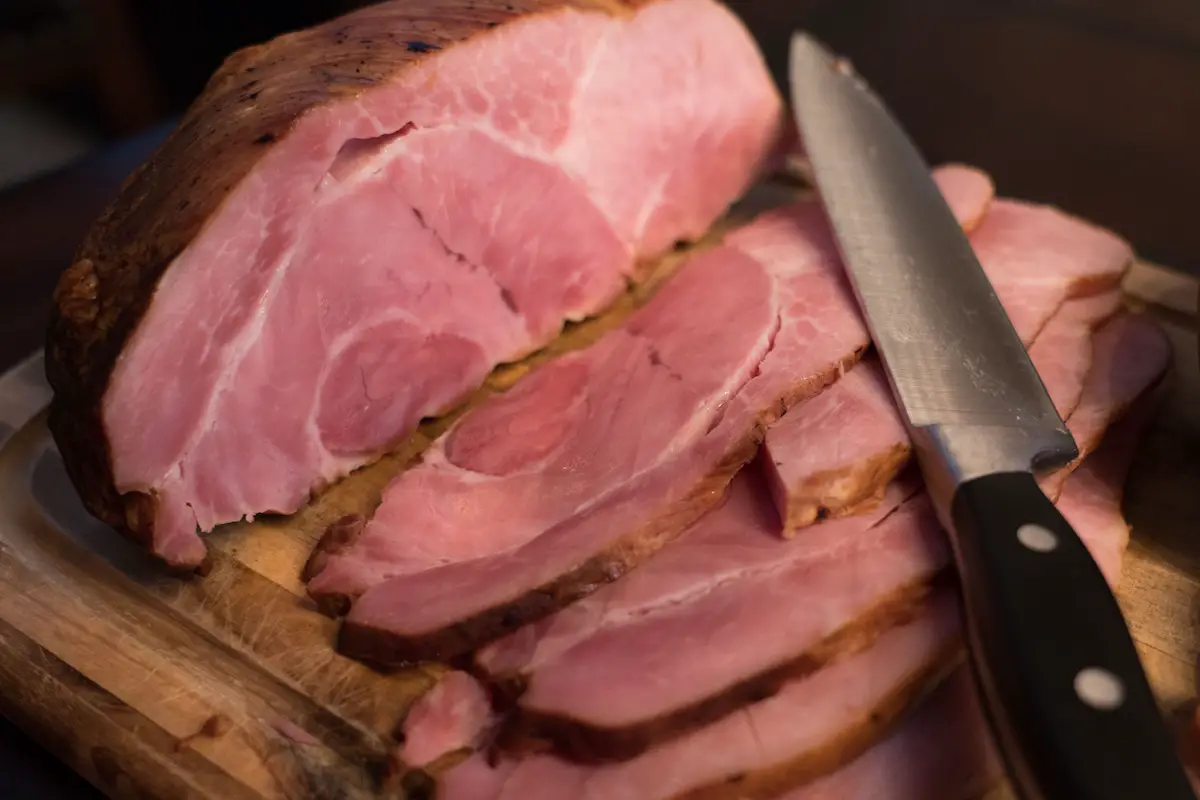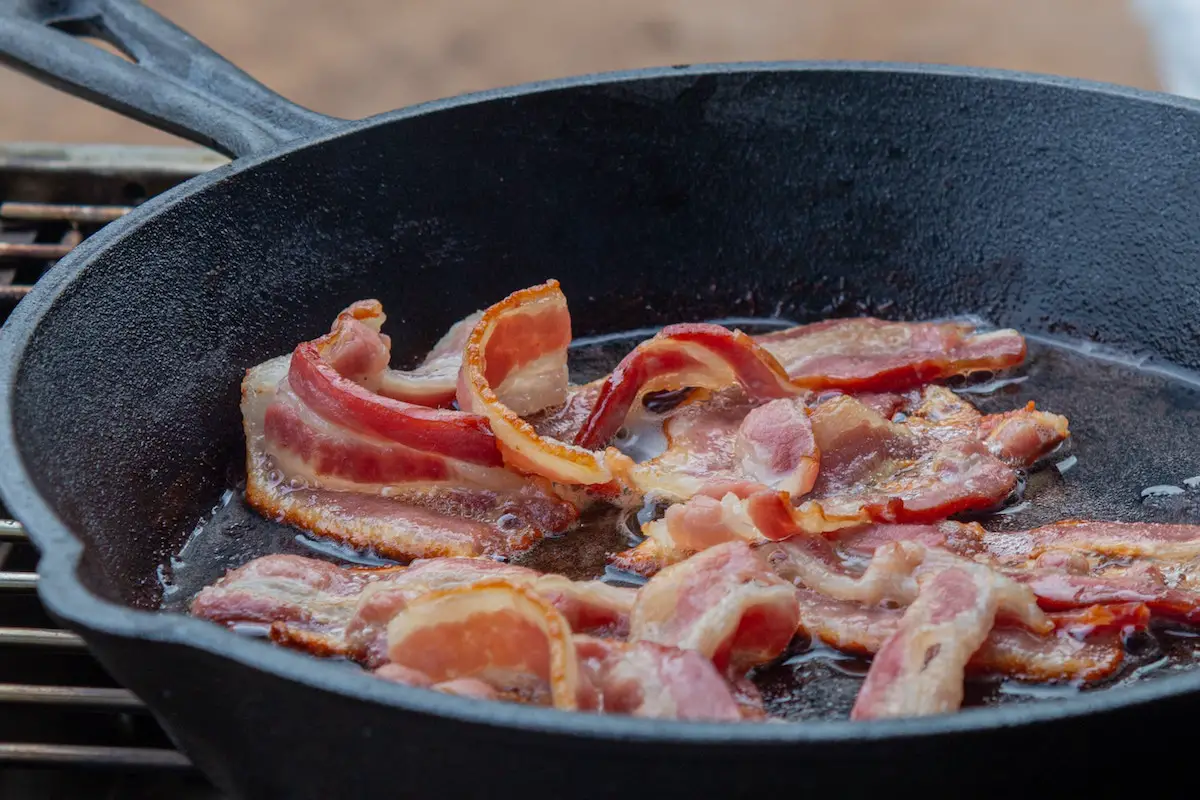Ham and bacon both are pork meats, but they are cut from different parts of the pig. Bacon can come from different parts of the pig, like the back, belly, or sides. Ham is usually cut from the back leg.
If you’re a meat lover, you’ve probably heard of ham and bacon. People often use these two pork products interchangeably, but they taste, feel, and are made in very different ways.
If you know the difference between ham and bacon, you can pick the right one for your recipe or meal.
For most people, ham and bacon seem like quite similar pork products. After all, they both come from pigs and have a distinctly meaty, salty flavor. However, there are some clear differences between these two types of cured meat that are worth understanding.
Defining Ham
Ham refers to pork that is taken from the hind leg of a pig. It is cured smoked or both in order to preserve it and enhance the flavor. Ham can be enjoyed as a whole cut of meat, such as a fresh ham or country ham. It can also be further processed into smaller pieces like ham steaks, boneless ham rolls, and deli-style sliced ham.
The curing process is what sets ham apart from a basic pork roast Traditionally, ham is cured with salt, then sometimes also smoked over fragrant wood chips Wet curing injects a brine solution deep into the meat for extra flavor and moisture. Dry curing coats the outside of the ham with salt, spices, and sugar. This drawn-out curing timetenderizes the meat while infusing it with a salty, smoky taste.
The Skinny on Bacon
Bacon is made from pork belly, which is the fatty area that runs along the underside of a pig below the loin. Pork bellies are heavily layered with fat streaks throughout, which renders out during cooking to create that coveted crispy bacon texture. Besides the belly, bacon can also come from other fatty areas like the back, sides, or jowl.
Bacon is nearly always cured with salt, then smoked at low temperatures to cook it and add flavor. The curing mixture frequently contains spices like pepper or maple sugar to complement the pork. After curing and smoking, bacon is sliced into long, thin strips before being packaged for sale.
So while ham and bacon both use curing and smoking techniques, bacon relies on external flavor applications while ham develops deeper flavor within the meat.
Key Differences Between Ham and Bacon
Now that we’ve defined these pork products, let’s clearly outline the main distinctions between ham and bacon:
-
Cut of meat – Ham comes from the hind leg, while bacon comes from the belly/sides/back.
-
Level of processing – Ham can be sold as a whole, bone-in cut or further processed. Bacon is always processed into slices before sale.
-
Curing method – Hams are typically cured through longer wet or dry curing. Bacon is cured with an quicker dry rub.
-
Cooking method – Ham is often smoked or baked whole. Bacon is smoked then pre-sliced to finish cooking later.
-
Fat content – Ham has fat mixed throughout the meat. Bacon is very fatty with fat layers throughout.
-
Flavor – Ham has a deep, porky flavor. Bacon is smokier with spice notes.
-
Uses – Ham is very versatile for sandwiches, entrees, and recipes. Bacon plays a supporting role as a flavor enhancer.
As you can see, the differences go far beyond just saltiness or place of origin on the pig. The curing and cooking processes distinguish ham and bacon into their own unique categories of pork products.
Popular Types of Ham and Bacon
There are endless varieties of cured ham and bacon available. Here are a few of the most common types you’re likely to encounter:
Types of Ham
- City ham – The most mild-flavored wet-cured ham, often sold pre-cooked.
- Country ham – Dry-cured and smoked for over a year for intense flavor.
- Black forest ham – A European smoked ham seasoned with spices.
- Prosciutto – Italian dry-cured ham that is also air dried.
- Spiral cut ham – Ham cut vertically for quick glazing and cooking.
- Boneless ham – Sold without the leg bone for convenience.
Types of Bacon
- Regular smoked – The typical bacon sold pre-packaged or at a butcher.
- Thick-cut bacon – A thicker slice for a chewier texture.
- Peppered bacon – Smoked bacon seasoned with cracked black pepper.
- Maple bacon – Sweetened with maple syrup during curing.
- Turkey bacon – Made from cured and smoked turkey rather than pork.
- Pancetta – Un-smoked Italian bacon used for cooking rather than eating plain.
As you can see, there are endless variations of flavors, textures, smoking methods and even meat sources when it comes to ham and bacon. Getting to know the main differences helps you select the right one for your recipe or preferences.
Key Uses for Ham and Bacon
Bacon and ham both play important but very distinct roles in cooking. Here’s an overview of how they are typically used:
-
Ham can be baked, grilled or simmered on its own as a hearty entree. It also adds robust flavor to soups, beans, grain bowls and more.
-
Bacon is most often used as a smoky, savory seasoning ingredient. It’s fantastic in classics like bacon and eggs or a BLT sandwich. Bacon also livens up Brussels sprouts, roasted potatoes and fresh salads.
-
Deli ham and bacon are both stellar sandwich and wrap fillings. They provide a hit of meaty satisfaction with each bite.
-
Small ham or bacon pieces add a pop of flavor when used in pastas, pizza, omelets, biscuits, and other tasty dishes across cuisines.
Satisfying Your Cravings
Whether you’re craving a thinly sliced deli sandwich or freshly baked ham, crispy bacon strips or pecan-smoked bacon baked beans, now you know a bit more about how to satisfy your pork cravings!
Ham and bacon have clearly different origins and preparation methods, but they complement each other beautifully. There’s no better way to start the day than with a classic ham, bacon and cheese omelet or breakfast sandwich. Then end your night with a wedge of hearty ham steak or juicy BLT.
Now that you understand the key distinctions between ham and bacon, you can deliberately choose which one fits your recipe or preferences best. So go ahead – grab a pack of bacon or slice of ham and start satisfying your pork cravings today!

Ham Vs Bacon: What’s The Difference?
Ham and bacon are both popular pork meats that are often used in a variety of dishes.
In a lot of ways, they are the same, but there are also some important differences that make them different.
This part will talk about how ham and bacon are different in terms of taste, texture, and how they are cooked.
Ham and bacon have distinct flavors that are a result of their different preparation methods.
Ham is typically less salty and has a milder flavor than bacon. It has a slightly sweet taste and is often used in sandwiches or as a main dish.
Bacon, on the other hand, is known for its salty and smoky flavor. It is often used as a breakfast food or added to dishes for a burst of flavor.
Besides American bacon, there are other kinds of bacon that taste very different, like Irish bacon.
The texture of ham and bacon is also different. Ham is typically softer and less chewy than bacon.
It has a smoother texture and is often sliced thin. Bacon, on the other hand, is crispy and crunchy.
It’s chewy and is usually served in strips or cut up and added to dishes to give them more texture.
Ham and bacon require different cooking methods. Ham can be cooked in a variety of ways, including baking, boiling, or grilling.
It’s often sliced thin for sandwiches or cubed to use in casseroles or soups. You can eat it fresh or cured.
Bacon is typically fried or baked until crispy. It is often served as a breakfast food or added to dishes for flavor and texture.
Overall, even though both ham and bacon are made from pork, they taste, feel, and are cooked in very different ways.
Ham is milder and softer, while bacon is salty, smoky, and crispy.
Both meats are versatile and can be used in a variety of dishes, depending on your preferences.
Ham is a type of meat that comes from the hind leg of a pig. It is a popular food item that can be found in many different forms and styles.
Ham can be eaten raw, but it is typically cooked before it is consumed.

There are many different types of ham available, each with its own unique flavor and texture. Some of the most popular types of ham include:
- This kind of ham comes from Italy and is usually aged for at least a year. It tastes salty and savory and feels soft and tender.
- Serrano Ham: This kind of ham is from Spain and always has been aged for at least 18 months. It tastes nutty and slightly sweet, and it’s firm and chewy.
- Cooked Ham: This kind of ham is done cooking and ready to eat. Thin slices of it are often put on sandwiches or salads or pizzas to make them taste better.
- Smoked Ham: This kind of ham is cured and then smoked to make it taste better. It can be eaten cold or heated up before serving.
Ham can be used in a variety of different recipes, including sandwiches, salads, and casseroles.
It is a versatile ingredient that can be enjoyed in many different ways.

If you are a meat lover, you must have heard of bacon. Bacon is a type of cured meat that comes from the back, belly, or loin of a pig.
It is a popular breakfast food and is used in many dishes for its unique flavor. Here is everything you need to know about bacon.
In the market, there are different kinds of bacon, and each one tastes and feels different.
Here are some of the most popular types of bacon:
- Back bacon is leaner than other types of bacon because it is made from the loin of the pig. It is popular in the UK and Canada.
- Streaky bacon is made from a pig’s belly and has more fat than back bacon. It is commonly used in the US.
- Pancetta: Pancetta is an Italian bacon made from rolled bacon that has been cured. It is often used in pasta dishes.
- Canadian bacon: Like back bacon, Canadian bacon is made from the loin of the pig. It is popular in Canada and the US.
- American bacon is more lean than Irish bacon, which comes from the back of the pig. It is commonly used in traditional Irish breakfast dishes.
- Canadian bacon is made from the belly and back of the pig, and English bacon is made from the same parts. It is popular in the UK.
The way bacon is cut can affect its taste and texture.
Here are some of the most common cuts of bacon:
| Cut | Description |
|---|---|
| Rashers | Thinly sliced bacon that is popular in the UK and Ireland. |
| American Bacon | Thickly sliced bacon that is popular in the US. |
Bacon is usually cured and smoked to give it its unique flavor, no matter what kind or cut it is.
The shape and taste of bacon can vary depending on the type, cut, and preparation method.
Know what bacon is and the different cuts and types that are out there. Pick the right bacon for your next meal.
When it comes to comparing ham and bacon, many people wonder which one is healthier.
Bacon and ham both have a lot of protein, but they also have a lot of fat and sodium.
Here’s a breakdown of the nutritional differences between the two:
| Ham (3 oz) | Bacon (3 oz) | |
|---|---|---|
| Calories | 136 | 369 |
| Protein | 19g | 23g |
| Fat | 5g | 30g |
| Sodium | 1,038mg | 1,149mg |
As you can see, bacon is significantly higher in calories, fat, and sodium than ham. Ham is a better source of protein per calorie than bacon.
However, bacon does contain slightly more protein per serving than ham.
That being said, it’s important to remember that both ham and bacon are processed meats, which have been linked to a higher risk of heart disease, cancer, and other health problems.
Choose leaner cuts of pork or other protein-rich foods like chicken or fish if you want to eat something healthier.
In conclusion, both ham and bacon can be part of a healthy diet in small amounts. However, ham is usually thought to be the better choice because it has fewer calories, fat, and sodium.
Uses of Ham and Bacon
Ham and bacon are both great foods to use in a lot of different recipes to make them taste and feel better.
Ham is often used in soups, salads, and as a standalone dish for dinner or lunch. It can also be used in recipes such as quiches, casseroles, and sandwiches.
Bacon, on the other hand, is a popular ingredient in breakfast dishes such as eggs, pancakes, and waffles.
It can also be used as a topping on pizzas, salads, and sliders. Additionally, bacon strips can be wrapped around other foods to add flavor and moisture.
Difference Between Ham and Canadian Bacon
FAQ
Which is better for you, bacon or ham?
Can you use ham as bacon?
Is back bacon just ham?
Is English bacon just ham?
What is the difference between Bacon and Ham?
Bacon is meat taken from the back, loin or belly of the pig. Bacon is either dry cured in cold air or by smoking or packed with large amounts of salt, or wet cured when it is immersed in liquid brine. Ham is meat cut from the thigh or rump of the pig. Ham can be cooked and served fresh or wet or dry cured usually with less salt and more sugar.
Is honey baked ham as good as regular ham?
The addition of honey will affect the calorie content of the food. One tablespoon of honey contributes to approximately 64 calories. In addition, the use of heat when making baked ham will reduce the quality of the honey.
Is Ham healthier than bacon?
When it comes to comparing ham and bacon, many people wonder which one is healthier. Both ham and bacon are high in protein, but they also contain a significant amount of fat and sodium. Here’s a breakdown of the nutritional differences between the two: As you can see, bacon is significantly higher in calories, fat, and sodium than ham.
Does Ham have more protein than bacon?
There is no more protein in ham compared to bacon. Bacon contains 37 g of protein for every 100 g, whereas ham contains 21 g [ 5 ]. Ham contains 26 IU of Vitamin D for every 100 g, while bacon has none. Bacon and ham have comparable levels of Vitamin E – ham contains 0.27 mg of Vitamin E for every 100 g, and bacon has none.
